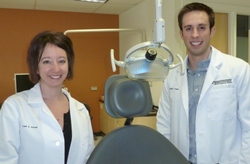
When 50 second-year dental students received their white coats in a January ceremony at the University of Colorado School of Dental Medicine, at least two of them had a family dentist to thank for the direction their careers had taken.
In high school, J.T. Crepps spent a day shadowing his long-time dentist, Dr. Lee Smith, who graduated from CU School of Dental Medicine in 1994.
“A lot of the professionals I shadowed didn’t look like they were having fun,” Crepps said. “Dr. Smith was high-fiving his patients and having a great time. That’s when I realized you can become a dentist and have fun.”
After college and a series of short-term jobs, Leah Schulz had a heart-to-heart with the dentist who had cared for her family for 30 years. “I realized that being a dentist is the best-kept secret. You can have a great professional career and have great hours and control over your life.”
While Crepps and Schulz may have both been inspired by family dentists, they also agree that their practices will likely look very different from the ones that led them to the University of Colorado.
“I was a real person. I mattered.”
J.T. Crepps knew he enjoyed interacting with people and working with his hands. In dentistry, he felt he could combine the two. When it came time to apply to dental school, he interviewed at six different schools, but the decision was an easy one.
“The University of Colorado facilities are by far the most up-to-date,” he said. “The class size is the smallest, and I love Colorado, so coming here to school was a no-brainer for me.”
Schulz took a more circuitous route to the University of Colorado, a path she calls “crazy.” She earned a BS in sociology and then decided she didn’t see any real-life application for her degree. She considered med school. She took a series of administrative jobs, but she kept coming back to the idea of a job connected to health care.
Then, after that discussion with her family dentist, she spent a year working as a dental assistant for a Fort Collins general dentist, Dr. Stephen Creal. She knew she had found a good fit. Determined to be admitted on her first try, she applied to 15 dental schools. At the University of Colorado, she found a home, largely because of a connection she made during the admissions process.
“When I would call Admissions, Barbara Swedensky would answer the phone, and she made it so clear that I wasn’t a number,” Schulz said. “I was a real person. I mattered.”
Today, Schulz still feels that same sense of community in her classes, and she praises the school for “the great technology, the smaller class size and the amazing labs.”
“One door closes, another opens.”
When Crepps and Schulz look to the future, they know that their chosen profession is changing and they may have to change their career expectations also.
Crepps points to the cost of technology as the reason dentists may no longer be able to continue as solo practitioners. He believes that in order to cover overhead costs, a lot of dentists will need to increase the size of the groups they practice in. He also thinks that student debt will direct the plans of future dentists. By the time he graduates, he will have student loans totaling $200,000.
“I am not going to have the finances or the credit to open a solo practice immediately upon graduating,” he said. “But when one door closes, another one opens. A lot of us will begin as associates in established practices or complete general practice residencies to refine our skills before we enter the private practice world.”
Schulz envisions the future of dentistry as a “more competitive” environment, where dentists will have to ask the question “How can I provide quality care for less money?” She also hopes to create a practice where she will devote time to dental missions, providing dental care to underserved populations.
“A lot of people have made sacrifices to get me to where I am,” she said. “Now I want to give back to the community, whether it’s in Colorado or somewhere else in the world.”
"We are not taking care of a tooth; we are taking care of a person."
The white coat ceremony for dentists marks the time—after 18 months of rigorous study, training and testing—when students begin working with patients in School of Dental Medicine clinics. But the symbolism serves to remind students that they are new members of a profession that balances scientific excellence with compassionate patient care.
To her surprise, Leah Schulz found the ceremony moving.
"I had expected the ceremony to be purely symbolic, but it was actually quite touching,” she said. “Listening to leaders from the dental community talk about our future patients and the ethical standards that will guide us resonated with me more than ever, as we're now transitioning from student to caregiver."
For Crepps, receiving his white coat served exactly the purpose intended.
“It was a good reminder about the importance of providing health care ethically,” he said. “It helps us remember we are not taking care of a tooth, we are taking care of a person—a person with feelings who deserves to be treated to the best of our abilities.”
Published: Feb.13, 2012

.png)

